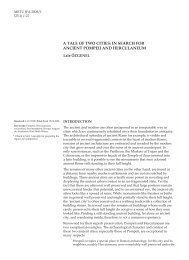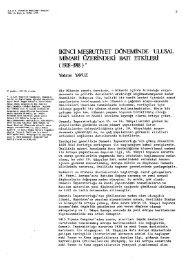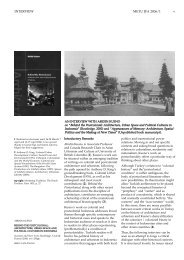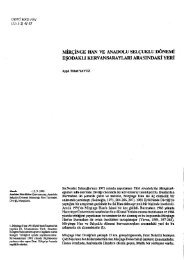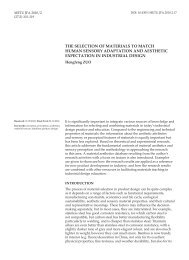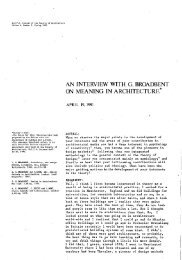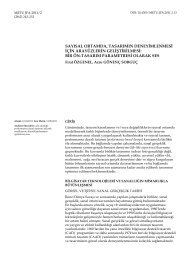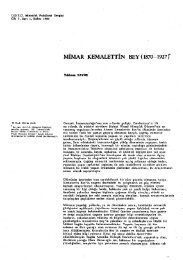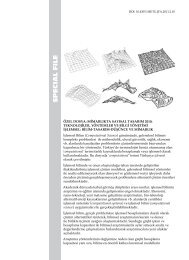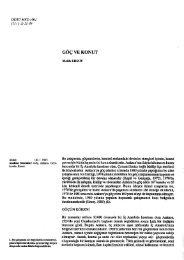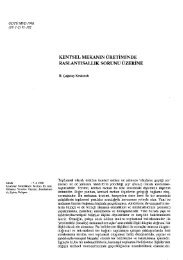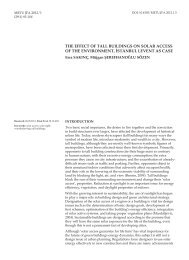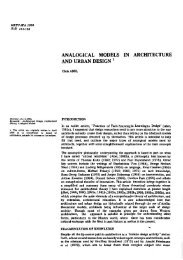bruno taut and the program for the protection of monuments in turkey
bruno taut and the program for the protection of monuments in turkey
bruno taut and the program for the protection of monuments in turkey
You also want an ePaper? Increase the reach of your titles
YUMPU automatically turns print PDFs into web optimized ePapers that Google loves.
30 METU JFA 2010/2<br />
82. Conrads <strong>and</strong> Sperlich (1962, 44-5).<br />
83. “Zunächst werden von den Mauern<br />
alle Kacheln entfernt, die nicht alt s<strong>in</strong>d. Die<br />
übrigbleibenden alten Kacheln muss man<br />
durch hydraulischen kalk besser befestigen.<br />
Sodann verputzt man alle Flächen, die ke<strong>in</strong>en<br />
kachelbelag haben. Es wird das die Mehrzahl<br />
aller Flächen se<strong>in</strong>, und zwar vollständig die<br />
Flächen nach Süden, Südesten und Südwesten.<br />
Um für die allgeme<strong>in</strong>e grosse Wirkung der<br />
Türbe und fürihre Fernwirkung den bisherigen<br />
E<strong>in</strong>druck zu erhalten, würde man mit e<strong>in</strong>em<br />
der modernen M<strong>in</strong>eralanstriche weiterkommen<br />
als mit der Nachahmung der alten Kacheln.<br />
Da die alte Glasur matt war, so halte ich es<br />
für durchaus möglich, beispielsweise mit den<br />
Keim’schen M<strong>in</strong>eralfarben genau denselben<br />
E<strong>in</strong>druck der Fernwirkung zu erreichen, wie<br />
ihn die alten Kacheln bieten. Da, wor früher die<br />
reichen Frieskacheln waren, würde ich e<strong>in</strong>en<br />
entsprechenden grauen Ton empfehlen, damit der<br />
allgeme<strong>in</strong>e architektonische E<strong>in</strong>druck der Türbe<br />
sichergestellt ist.“ Bruno Taut, Bericht über die<br />
Renovierung der Yeşil Türbe <strong>in</strong> Bursa (ISA, Iw<br />
45, 1938, 5-6).<br />
GIORGIO GASCO<br />
goal to accentuate <strong>the</strong> “Turkish” character <strong>of</strong> <strong>the</strong> towns throughout <strong>the</strong><br />
whole country. The “Turkish” character <strong>of</strong> Bursa is symbolically recalled<br />
by <strong>the</strong> Türbe’s turquoise outl<strong>in</strong>e that st<strong>and</strong>s out from <strong>the</strong> l<strong>and</strong>scape <strong>and</strong> at<br />
<strong>the</strong> same time is stored <strong>in</strong> <strong>the</strong> cladd<strong>in</strong>g <strong>of</strong> <strong>the</strong> orig<strong>in</strong>al İznik tiles.<br />
Taut recognizes that <strong>the</strong> mausoleum has a strong iconic value, which is able<br />
to turn it <strong>in</strong>to a l<strong>and</strong>mark. Beyond its function as a tomb, as a monument<br />
built to keep <strong>the</strong> deceased’s memory, Taut’s read<strong>in</strong>g privileges a more<br />
abstract symbolic role: <strong>the</strong> build<strong>in</strong>g becomes <strong>the</strong> sanctuary <strong>of</strong> <strong>the</strong> collective<br />
memory <strong>of</strong> <strong>the</strong> country. This shift from <strong>the</strong> classical idea <strong>of</strong> <strong>the</strong> monument<br />
to <strong>the</strong> unconventional <strong>in</strong>terpretation <strong>of</strong> <strong>the</strong> build<strong>in</strong>g as a structure<br />
functional to <strong>the</strong> display <strong>of</strong> <strong>the</strong> İznik tile coat<strong>in</strong>g’s fragments allows <strong>the</strong><br />
Türbe to be a sort <strong>of</strong> pavilion to exhibit <strong>the</strong> past. It does not seem so rash<br />
to imag<strong>in</strong>e that <strong>in</strong> <strong>the</strong> Yeşil Türbe Taut detected some echoes <strong>of</strong> <strong>the</strong> idea<br />
<strong>of</strong> “fantastic architecture” that sprung from his Glashaus built at <strong>the</strong> 1914<br />
Cologne Werkbund Exposition. The outl<strong>in</strong>e itself <strong>of</strong> <strong>the</strong> Glashaus somehow<br />
revealed an oriental taste, which does not appear so strange consider<strong>in</strong>g<br />
<strong>the</strong> emphasis Paul Scheerbart has <strong>for</strong> orient <strong>and</strong> oriental mysticism <strong>in</strong><br />
his Glasarchitektur, <strong>the</strong> text he dedicated to Bruno Taut. Fur<strong>the</strong>rmore, a<br />
similar astonish<strong>in</strong>g effect, due to a space emerg<strong>in</strong>g out <strong>of</strong> <strong>the</strong> <strong>in</strong>terplay <strong>of</strong><br />
light <strong>and</strong> colour (82), seems <strong>in</strong>deed to occur <strong>in</strong> <strong>the</strong> feature <strong>of</strong> <strong>the</strong> Türbe: it<br />
is possible to recognize a similar tension between <strong>the</strong> strik<strong>in</strong>g outl<strong>in</strong>e <strong>of</strong><br />
<strong>the</strong> construction <strong>and</strong> <strong>the</strong> multi-sensory experience <strong>of</strong>fered by <strong>the</strong> specific<br />
features <strong>of</strong> its glaze tiles. In <strong>the</strong> central part <strong>of</strong> <strong>the</strong> report Taut provides a set<br />
<strong>of</strong> advice to keep <strong>and</strong> to protect <strong>the</strong> two ends <strong>of</strong> such a tension:<br />
“First <strong>of</strong> all, <strong>the</strong> new <strong>and</strong> <strong>in</strong>congruous ceramic tiles must be removed. The<br />
old ones must be stabilized by <strong>the</strong> use <strong>of</strong> hydraulic lime <strong>and</strong> <strong>the</strong> walls that<br />
lost <strong>the</strong>ir tiles must be plastered. This concerns a major part <strong>of</strong> <strong>the</strong> walls,<br />
<strong>the</strong> whole south, south-east <strong>and</strong> south-west sides. In order to preserve <strong>the</strong><br />
Tomb’s present appearance, <strong>for</strong> its both close <strong>and</strong> distant impressions, it<br />
could be possible to achieve a good result by employ<strong>in</strong>g a modern metallic<br />
pa<strong>in</strong>t <strong>in</strong>stead <strong>of</strong> us<strong>in</strong>g new ceramic tiles, which are badly reproduc<strong>in</strong>g old<br />
ones. Tak<strong>in</strong>g <strong>in</strong>to account that tiles’ old glazed surfaces were opaque, as<br />
<strong>for</strong> me with “Keim m<strong>in</strong>eral pa<strong>in</strong>ts” it is possible to successfully reproduce<br />
this impression <strong>of</strong> opacity from a distance. In order to enhance <strong>the</strong> Türbe’s<br />
general architectonic impression, I advise to put ash colour clay where rich<br />
frame tiles were once <strong>in</strong> order to ensure <strong>the</strong> Tomb’s architectonic general<br />
impression. It is unquestionably difficult to have <strong>the</strong> same old colour by<br />
us<strong>in</strong>g plaster; <strong>in</strong> order to have required strength on <strong>the</strong> o<strong>the</strong>r h<strong>and</strong>, his price<br />
would <strong>in</strong>crease. Never<strong>the</strong>less, <strong>in</strong> relation to <strong>the</strong> perception <strong>of</strong> <strong>the</strong> build<strong>in</strong>g<br />
from a distance, it is possible to achieve a better result than be<strong>for</strong>e if colours<br />
are tested <strong>and</strong> <strong>the</strong>ir shades are carefully determ<strong>in</strong>ed. The sightseer, go<strong>in</strong>g<br />
through <strong>the</strong> garden, will notice, <strong>of</strong> course, <strong>the</strong> difference between old tiles<br />
<strong>and</strong> additional coloured plaster. But, <strong>in</strong> this way <strong>the</strong> build<strong>in</strong>g’s reality will<br />
be manifested as much as <strong>the</strong> old has not been touched <strong>and</strong> <strong>the</strong> new po<strong>in</strong>ts<br />
out itself just as it is.” (83)<br />
Taut here suggests a bold <strong>and</strong> sophisticated alternative to <strong>the</strong> edit<strong>in</strong>g <strong>of</strong><br />
<strong>the</strong> monument accord<strong>in</strong>g to imitative criteria that had dist<strong>in</strong>guished <strong>the</strong><br />
previous phases <strong>of</strong> restoration. In that case, restorers looked at <strong>the</strong> orig<strong>in</strong>al<br />
tiles as <strong>the</strong> au<strong>the</strong>ntic element worth to be imitated <strong>in</strong> order to ground <strong>the</strong><br />
identity <strong>of</strong> <strong>the</strong> monument both with a material <strong>and</strong> symbolic po<strong>in</strong>t <strong>of</strong> view.<br />
Taut’s <strong>in</strong>terpretation <strong>of</strong> <strong>the</strong> au<strong>the</strong>nticity <strong>of</strong> <strong>the</strong> monument <strong>in</strong>stead focuses<br />
on a specific element <strong>of</strong> those orig<strong>in</strong>al tiles: <strong>the</strong> turquoise colour <strong>of</strong> <strong>the</strong>ir<br />
glaze. Actually, this blue-green colour is precisely <strong>the</strong> dist<strong>in</strong>guish<strong>in</strong>g mark<br />
<strong>of</strong> <strong>the</strong> monument (Yeşil Türbe = Green Tomb) <strong>and</strong> <strong>of</strong> <strong>the</strong> city itself (“Green<br />
Bursa”). But at <strong>the</strong> same time this particular colour becomes <strong>the</strong> suitable



